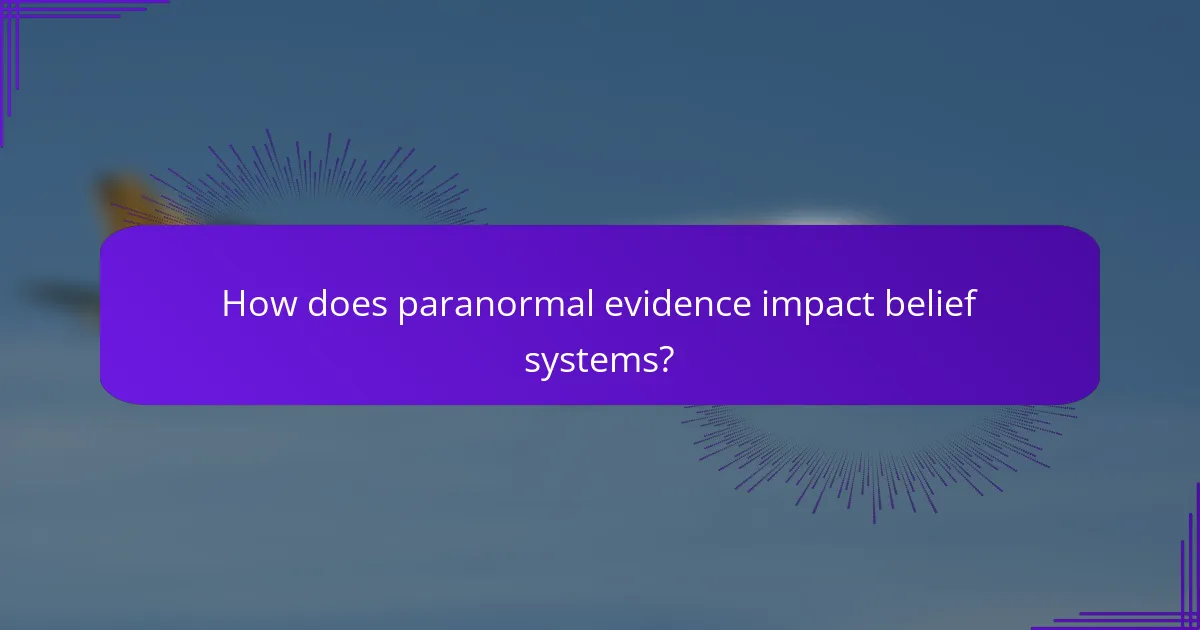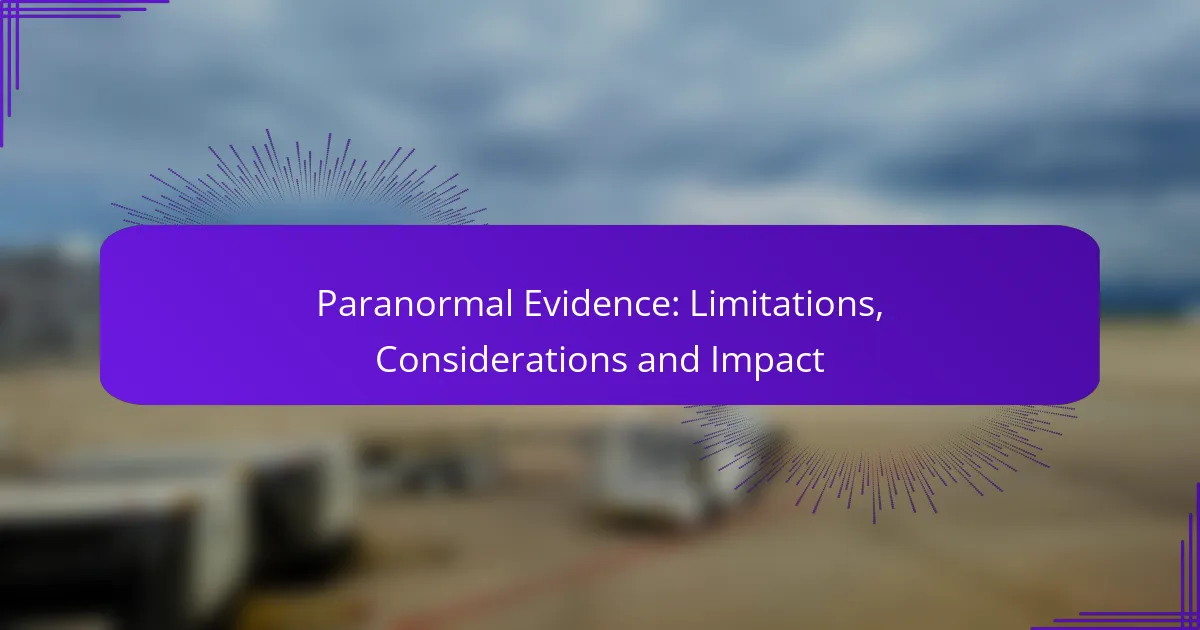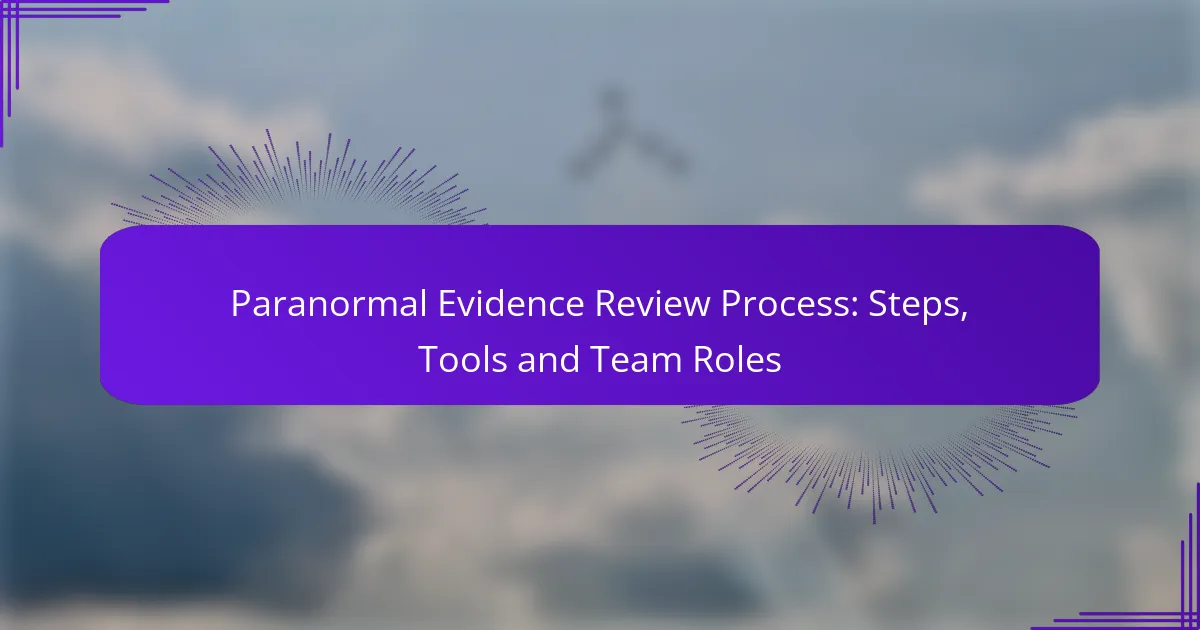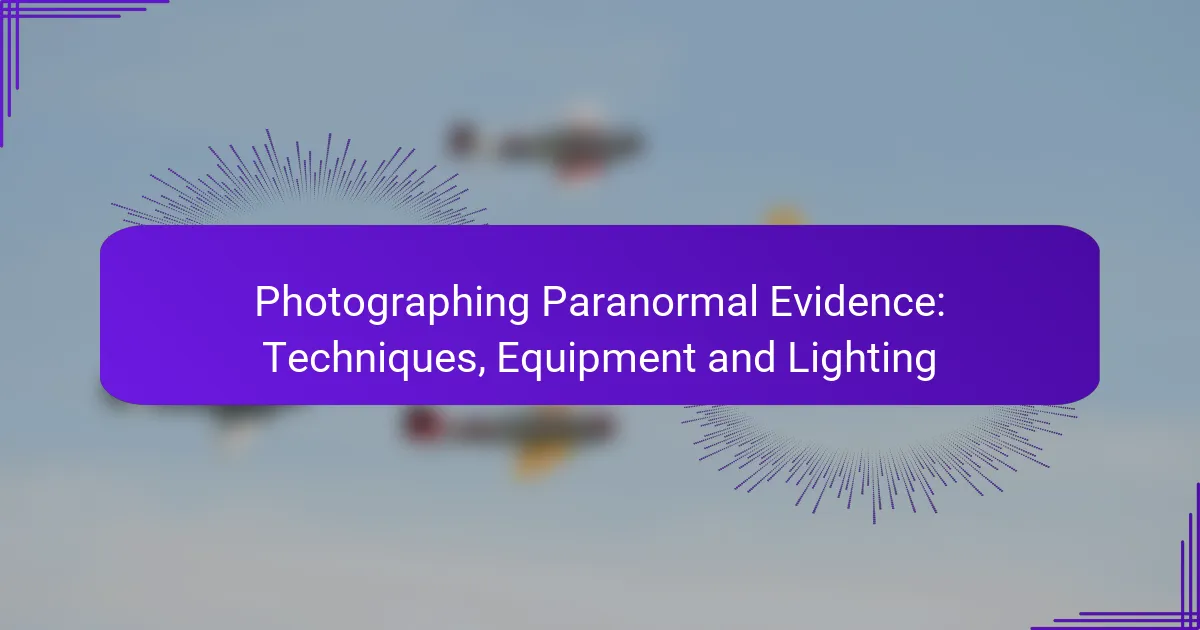Paranormal evidence presents unique challenges in terms of credibility and interpretation, influenced by factors such as scientific validation and subjective experiences. Its impact on belief systems can be profound, often shaping perceptions of reality and spirituality. To effectively evaluate such evidence, it is essential to apply critical thinking and consider the ethical implications surrounding these claims.

What are the limitations of paranormal evidence?
The limitations of paranormal evidence stem from various factors that affect its credibility and interpretation. These include a lack of scientific validation, subjective experiences, inconsistent findings, technological constraints, and the potential for misinterpretation.
Lack of scientific validation
Paranormal evidence often lacks rigorous scientific validation, making it difficult to accept within the scientific community. Many claims are based on anecdotal experiences rather than controlled experiments, which diminishes their reliability.
Without standardized methods for testing paranormal phenomena, results can vary widely, leading to skepticism among researchers. This absence of empirical support means that many paranormal claims remain unproven or dismissed as pseudoscience.
Subjectivity of experiences
The subjectivity of personal experiences plays a significant role in the interpretation of paranormal evidence. Individual perceptions can be influenced by emotions, beliefs, and cultural backgrounds, leading to varying conclusions about similar events.
For example, two people witnessing the same phenomenon may describe it differently based on their personal biases. This variability complicates the establishment of a common understanding of what constitutes valid paranormal evidence.
Inconsistency in findings
Inconsistency in findings is a major limitation of paranormal evidence, as results can differ significantly across studies and investigations. This lack of uniformity raises questions about the reliability of the evidence presented.
For instance, ghost hunting investigations may yield compelling evidence in one location but fail to produce similar results in another. Such discrepancies highlight the challenges of drawing definitive conclusions about paranormal phenomena.
Technological constraints
Technological constraints can hinder the collection and analysis of paranormal evidence. Many tools used in investigations, such as EMF meters and infrared cameras, have limitations in their sensitivity and accuracy.
Additionally, the interpretation of data collected through technology can be subjective, leading to potential errors in understanding what the evidence truly represents. This can result in false positives or misattributed phenomena.
Potential for misinterpretation
The potential for misinterpretation is a critical limitation when evaluating paranormal evidence. Observers may misread environmental cues or overemphasize coincidences, leading to incorrect conclusions about paranormal activity.
Common examples include attributing natural sounds or movements to supernatural causes without considering logical explanations. This tendency can skew public perception and contribute to the proliferation of unfounded paranormal claims.

How does paranormal evidence impact belief systems?
Paranormal evidence significantly influences belief systems by shaping individual perceptions of reality and spirituality. Such evidence can reinforce existing beliefs or challenge them, leading to shifts in how people understand the world around them.
Influence on personal beliefs
Personal beliefs are often molded by experiences with paranormal phenomena, which can lead individuals to adopt or reinforce spiritual or supernatural views. For example, someone who experiences an unexplained event may become more open to the idea of ghosts or other entities, altering their worldview.
Conversely, skepticism towards paranormal claims can strengthen a person’s reliance on scientific explanations, creating a divide in belief systems. This dynamic illustrates how personal experiences with paranormal evidence can either affirm or challenge one’s existing beliefs.
Effect on cultural narratives
Paranormal evidence plays a crucial role in shaping cultural narratives, often becoming embedded in folklore and traditions. Stories of hauntings, supernatural occurrences, and mythical creatures contribute to a culture’s identity and values, influencing collective beliefs.
These narratives can evolve over time, reflecting societal changes and technological advancements. For instance, modern interpretations of ghost stories may incorporate elements of technology, such as digital recordings, which can alter how these tales are perceived and shared within a community.
Role in community bonding
Communities often bond over shared beliefs in the paranormal, creating a sense of belonging among individuals with similar experiences or interests. Paranormal investigation groups, for example, can foster friendships and collaboration as members explore and discuss their findings.
Additionally, events such as ghost tours or paranormal conventions can strengthen community ties by bringing people together to share their stories and experiences. This communal aspect highlights the social dimension of belief in the paranormal, as it often transcends individual perspectives to create a collective identity.

What considerations should be made when evaluating paranormal evidence?
When evaluating paranormal evidence, it is crucial to apply critical thinking, understand the context of the evidence, and consider the ethical implications involved. These considerations help in assessing the validity and impact of claims related to paranormal phenomena.
Critical thinking approaches
Applying critical thinking involves questioning the sources of paranormal evidence and examining the methods used to gather it. Look for logical consistency, potential biases, and alternative explanations. For instance, a photograph claiming to show a ghost should be scrutinized for possible digital manipulation or environmental factors.
Utilizing a systematic approach, such as the scientific method, can help in evaluating claims. Formulate hypotheses, conduct experiments if possible, and analyze results to determine if they support or refute the paranormal assertion.
Importance of context
The context in which paranormal evidence is presented significantly influences its interpretation. Factors such as cultural beliefs, historical background, and the setting of the event can shape perceptions. For example, a haunting reported in a historic site may be viewed differently than a similar claim in a modern residential area.
Additionally, understanding the emotional state of witnesses can provide insights into the reliability of their accounts. High-stress situations may lead to misinterpretations of ordinary occurrences as paranormal events.
Ethical implications
Evaluating paranormal evidence raises ethical considerations, particularly regarding the impact on individuals and communities. Misleading claims can exploit vulnerable people, leading to emotional distress or financial loss. It is essential to approach such evidence with responsibility and integrity.
Furthermore, researchers and investigators should prioritize transparency in their methods and findings. Providing clear information about the limitations of the evidence can help prevent misinformation and promote informed discussions about paranormal phenomena.

How can one effectively document paranormal evidence?
Effectively documenting paranormal evidence involves a systematic approach that combines technology, standardized methods, and expert collaboration. This ensures that the evidence collected is credible, reproducible, and can withstand scrutiny.
Use of technology
Utilizing technology is crucial for capturing paranormal evidence accurately. Devices such as digital voice recorders, infrared cameras, and electromagnetic field (EMF) meters can help document phenomena that may not be visible to the naked eye. For example, an EMF meter can detect fluctuations in electromagnetic fields that some believe are associated with paranormal activity.
When using technology, ensure that equipment is calibrated and functioning properly. Regularly check batteries and settings to avoid false readings. Consider using multiple devices simultaneously to corroborate findings.
Standardized reporting methods
Implementing standardized reporting methods enhances the reliability of documented paranormal evidence. This can include detailed logs that note the time, location, environmental conditions, and specific observations made during investigations. A consistent format allows for easier comparison and analysis of findings over time.
Consider using templates that guide investigators through the documentation process. This might include sections for initial observations, equipment used, and any anomalies encountered. Standardization helps in maintaining objectivity and reduces the influence of personal bias.
Collaboration with experts
Collaborating with experts in fields such as psychology, physics, or history can provide valuable insights into paranormal investigations. Experts can help interpret findings and offer explanations that might not be immediately apparent to amateur investigators. For instance, a historian might provide context for a location’s reported hauntings.
Establishing partnerships with professionals can also lend credibility to your findings. When presenting evidence, having expert validation can strengthen claims and encourage a more serious examination of the data collected.

What are the common misconceptions about paranormal evidence?
Common misconceptions about paranormal evidence often stem from a lack of understanding of the distinction between belief and empirical fact. These misunderstandings can lead to skewed perceptions of what constitutes valid evidence in the realm of the paranormal.
Confusion between belief and fact
Many individuals conflate personal beliefs with objective facts, particularly in the context of paranormal phenomena. This confusion can result in the acceptance of unverified claims as truth, undermining critical analysis. For instance, a strong belief in ghosts may lead someone to interpret ambiguous experiences as evidence of their existence, despite a lack of scientific backing.
To navigate this confusion, it is essential to differentiate between subjective experiences and verifiable data. Engaging in critical thinking and seeking out empirical evidence can help clarify what is factual versus what is merely belief-based.
Overreliance on anecdotal accounts
Anecdotal evidence, while compelling, is often unreliable when assessing paranormal claims. Personal stories and testimonies can be influenced by cognitive biases, emotions, and social pressures, leading to distorted perceptions of reality. Relying solely on these accounts can create a skewed understanding of paranormal phenomena.
To avoid this pitfall, consider corroborating anecdotal evidence with scientific research or documented studies. A balanced approach that includes both personal experiences and empirical data can provide a more comprehensive view of paranormal claims.
Misunderstanding of scientific principles
Many misconceptions about paranormal evidence arise from a lack of understanding of basic scientific principles. Concepts such as the scientific method, falsifiability, and reproducibility are often overlooked, leading to the acceptance of untestable claims. For example, if a paranormal event cannot be reliably reproduced under controlled conditions, its validity remains questionable.
To address this misunderstanding, familiarize yourself with fundamental scientific concepts. Engaging with educational resources or discussions about scientific methodology can enhance your ability to critically evaluate paranormal evidence and discern credible claims from those lacking support.



